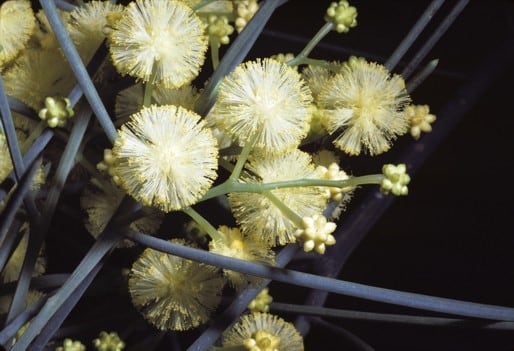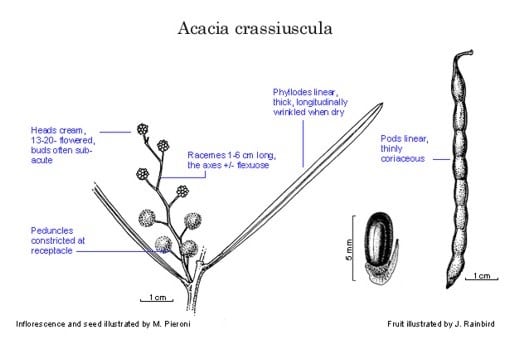Acacia crassiuscula H.L.Wendl.
WATTLE
Acacias of Australia
Family
Fabaceae
Distribution
Found in near-coastal areas from Albany E to Cape Arid Natl Park, W.A., with two discontinuous collections from north and NW of Walpole, c. 100 km W of Albany.
Description
Shrub 1–2.5 m high, often spindly. Branchlets glabrous. Phyllodes ascending to erect, linear, rarely terete, straight to shallowly incurved, 5–10 cm long, (1–) 2–4 mm wide, narrowed at base, obtuse to acute, mucronulate, with mucro sometimes ±pungent, thick, somewhat rigid, longitudinally rugose, dark green, glabrous; midrib rather prominent; gland (0.5–) 2–8 mm above pulvinus. Racemes 1–6 cm long, 3–8-headed, glabrous; axis ±flexuose; peduncles 4–8 mm long, constricted at receptacle; heads globular, 5.5–6 mm diam., 13–20 flowered, cream; buds often subacute. Flowers 5-merous; sepals united. Pods linear, shallowly constricted between seeds, 10 cm long, 4–5 mm wide, thinly coriaceous, glabrous; marginal nerve narrow, yellow. Seeds longitudinal, oblong to elliptic, 4.5–4.8 mm long, semi-glossy, black; aril terminal, thick.
Habitat
Grows in association with granite, often in white, granitic sand, sand over quartzite and rocky sand in scrub mallee and heath.
Specimens
W.A.: Whoogarup Ra., Fitzgerald R. Natl Park, M.I.H.Brooker 2746 (MEL, NSW, PERTH); Granite Peak, c. 32 km N of Walpole, A.S.George 11121 (MEL, PERTH); Cape Arid Natl Park, A.S.Weston 9684 (PERTH).
Notes
Plants with narrow phyllodes (1–1.5 mm wide, sometimes quadrangular-terete) occur mainly E of Esperance. Bentham applied the name A. pycnophylla var. angustifolia to these but the variant is not considered worthy of formal rank.
Superficially resembles A. cupularis which is a glabrous shrub, phyllodes with 2 or 3 glands, much shorter racemes with fewer, golden flower-heads on generally shorter peduncles that are not constricted at the receptacle and more or less submoniliform pods. Sometimes confused with A. harveyi which has uncinate phyllode-tips, smaller heads and the aril half or more encircling the seed. In phyllode shape and size, resembling A. euthyphylla.
The nomenclature of A. crassiuscula is complicated and is discussed by L.Pedley, Austrobaileya 1: 286 (1980). In Fl. Austral. 2: 372 (1864), G.Bentham misapplied the name to several taxa, including A. hamiltoniana, viz. Sieber 464 while at the same time describing true A. crassiuscula as A. pycnophylla.
FOA Reference
Data derived from Flora of Australia Volumes 11A (2001), 11B (2001) and 12 (1998), products of ABRS, ©Commonwealth of Australia
Author
B.R.Maslin
Minor edits by J.Rogers
This identification key and fact sheets are available as a mobile application:
URL: https://apps.lucidcentral.org/wattle/
© Copyright 2018. All rights reserved.











